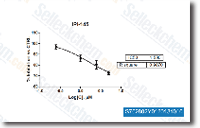It has been reported that each gefitinib and its des methyl metabolite formed through CYP2D6, inhib ited with a equivalent potency and selectivity subcellular EGFR tyrosine kinase activity. Having said that, M3 was 15 occasions significantly less active in a cell based assay and consequently it was assumed that this metabolite was unlikely to con tribute towards the activity of gefitinib in vivo due to poor cell penetration. Around the contrary, when metabolites M1, M2 and M3 were tested in our responsive cell models at concentra tions equivalent to that of gefitinib, they exhibited a signif icant inhibition of EGFR autophosphorylation and proliferation in intact cells, indicating their ability to enter cells and to interact with all the catalytic domain of EGFR.
Lastly, in gefitinib resistant cell lines M1, M2 and M3 metabolites have been poorly effective indicating that a minimum of these metabolites did not create kinase inhibitor additive toxic effects in NSCLC cell lines. In contrast to its abundant hepatic expression, CYP3A4 appears to play a minor role in lung metabolism, being expressed in only about 20% of circumstances. Actual time PCR analysis confirmed the lack of expression of this isoform in our NSCLC cell models, as reported for A549 cells. CYP2D6 was detected in all cell lines, whereas both CYP1A1 and CYP1A2 have been expressed at important levels in sensitive cells. Inducibility of CYP1A1 and CYP1A2 transcripts by gefitinib was clearly demonstrated in sensitive cell lines, when induction of CYP1A1 mRNA was not detected in resistant cell lines. EROD activity demonstrated a 3 6 fold induction of CYP1A1 elicited by gefitinib in sensitive cells.
To the very best of our understanding, that is the first time that the induction by gefitinib of relevant metabolic enzyme has been demonstrated. selleck chemical The purpose why gefitinib induces CYP expression and activity only in sensitive cells could possibly be ascribed to the ability of gefitinib to inhibit signal transduction pathway downstream EGFR. It has been lately demonstrated that EGF represses the dioxin mediated induction of CYP1A1 in normal human keratinocytes preventing recruitment of the p300 coactivator. For that reason,  EGFR signalling is a repressor with the aryl hydrocarbon receptor and regulates the transcription of a lot of genes such as CYP1A1. In this context, EGFR inhibi tors for example gefitinib, erlotinib, lapatinib or cetuximab may affect the induction of CYP1A1 in those cell sorts in which the drug successfully inhibits signalling controlled by EGFR. The inhibition of MAPK pathway may repre sent a link between EGFR inhibition and CYP1A1 induc tion considering that PD98059 and U0126, well-known MEK1 two inhibitors, induced CYP1A1 activity as did gefitinib in H322 cells, although none of PI3K AKT mTOR inhibitors tested was helpful.
EGFR signalling is a repressor with the aryl hydrocarbon receptor and regulates the transcription of a lot of genes such as CYP1A1. In this context, EGFR inhibi tors for example gefitinib, erlotinib, lapatinib or cetuximab may affect the induction of CYP1A1 in those cell sorts in which the drug successfully inhibits signalling controlled by EGFR. The inhibition of MAPK pathway may repre sent a link between EGFR inhibition and CYP1A1 induc tion considering that PD98059 and U0126, well-known MEK1 two inhibitors, induced CYP1A1 activity as did gefitinib in H322 cells, although none of PI3K AKT mTOR inhibitors tested was helpful.
MiRNA
A microRNA is a short ribonucleic acid (RNA) molecule found in eukaryotic cells
